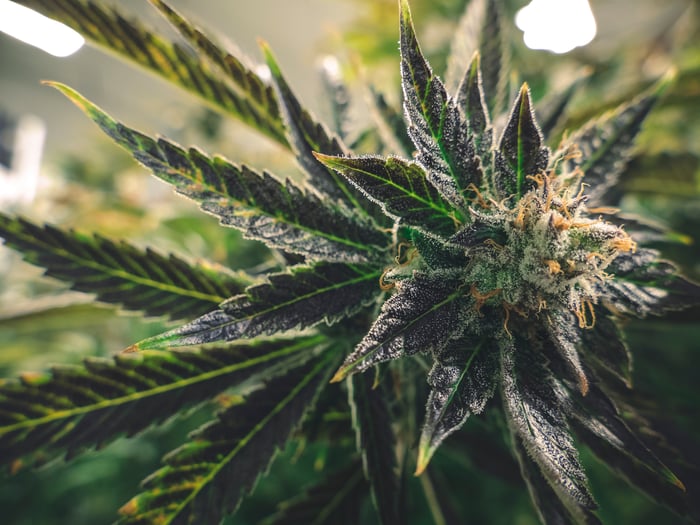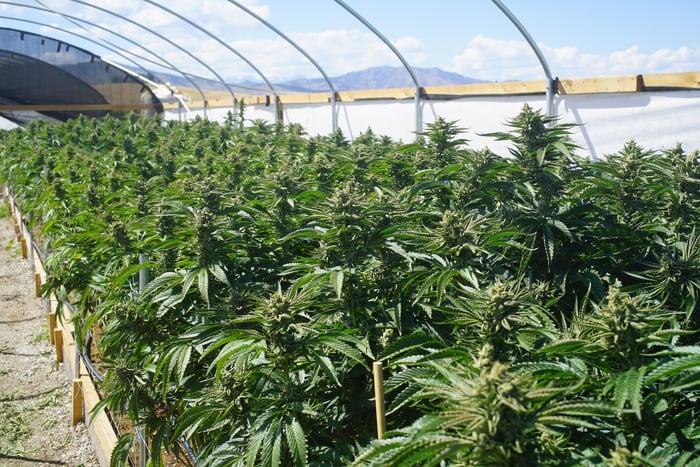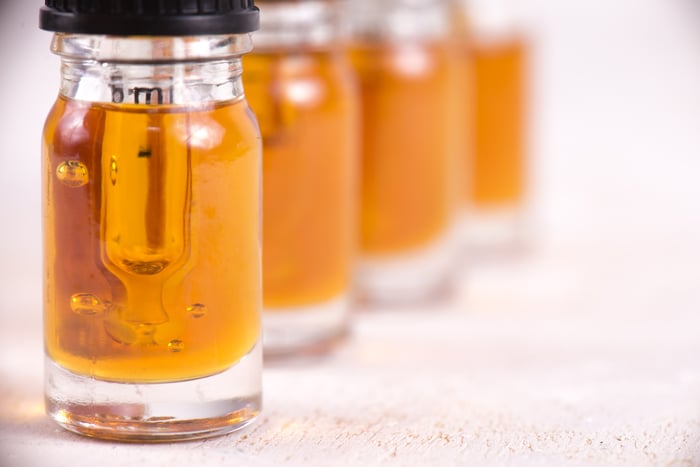The marijuana industry is budding at an extraordinary rate, as evidenced by the sales growth estimates from Arcview Market Research and BDS Analytics. The duo expects global cannabis sales to soar from $12.8 billion in 2018 to $31.3 billion by 2022. This revenue has to wind up somewhere, and Aurora Cannabis (ACB 12.87%) has a very good chance of nabbing a reasonable portion of the pie.
Aurora Cannabis is arguably the most popular, if not the most polarizing, pot stock of the industry. It's also on track to lead all growers in peak annual production potential. Though management is conservatively calling for in excess of 500,000 kilograms a year, it should be capable of up to 700,000 kilos annually when all is said and done. That makes Aurora Cannabis' earnings reports especially intriguing.

Image source: Getty Images.
Everything you need to know about Aurora Cannabis' Q2 earnings report
On Monday, Feb. 11, following the closing bell, Aurora Cannabis released its second-quarter operating results for fiscal 2019. Contained within its report and filing with SEDAR in Canada are 20 things -- some good, some bad -- investors are going to want to know. So, let's dive right in.
1. 363% sales growth
Having provided sales guidance in early January of between 50 million Canadian dollars (CA$50 million) and CA$55 million for Q2 2019, Aurora Cannabis delivered revenue near the upper end of that range, with CA$54.2 million in net sales, up 363% from the year-ago quarter. Although this was slightly ahead of Wall Street estimates, it should be noted that Wall Street had been expecting CA$67.4 million before the company's January-issued sales update.
2. Accounted for a fifth of all Canadian cannabis sales
There's little doubt at this point that Aurora will take its seat at the head of the production table, so to speak. According to available data from Health Canada, it accounted for 20% of all consumer sales for the Q2 2019 period (Oct. 1-Dec. 31). This would include the post-Oct. 17 period, which is when recreational weed went on sale in Canada.
3. Medical marijuana still representing a majority of weed sales
Interestingly enough, recreational pot sales still took a back seat to medical marijuana sales in Aurora's latest quarter. Net adult-use revenue hit CA$21.6 million, up from less than CA$0.6 million in the sequential first quarter, with medical cannabis sales rising modestly to CA$26 million from CA$24 million in the sequential first quarter. Expect recreational sales to leave medical sales in the dust beginning next quarter.

Image source: Getty Images.
4. Substantial growth in ancillary revenue
Don't forget that Aurora has other sales channels beyond cannabis. Its ancillary revenue channels, which include greenhouse design and construction services, patient counseling, analytical testing services, and horizontally integrated business revenue, totaled CA$6.6 million in Q2 2019, up from just CA$1.9 million in the year-ago quarter.
5. Benefiting from fair-value adjustments in Q2 2019
International Financial Reporting Standards (IFRS) accounting, which Canadian pot stocks abide by, has been more friend than foe in the early going for cannabis growers. During Q2, Aurora Cannabis realized a gross profit of CA$28.4 million prior to fair-value adjustments, but walked away with a net CA$3.7 million benefit from fair-value adjustments to its biological assets (i.e. marijuana plants) when all was said and done. Thus, its gross profit lifted to CA$32.1 million.
6. Tumbling prices for average dried cannabis price per gram
Although it's still early in the rollout of pot products, the per-gram price of dried cannabis tumbled 21% year over year and 26% from the sequential first quarter. The company attributed this decline to the 10% excise tax on recreational weed sales, as well as lower wholesale pricing.

Image source: Getty Images.
7. Double-digit drop in average per-gram extract prices
Now this was shocking. Not only did dried flower's per-gram price fall, but the price of extracts on a per-gram basis fell by 25% year over year and 18% from the sequential first quarter. Extracts are a traditionally higher-margin product, but excise taxes weighed down prices in the latest quarter.
8. Large operating loss, as expected
No surprise here: Aurora Cannabis is losing a lot of money if one-time benefits and costs are removed from the equation. Spending liberally on its capacity expansion, international push, and branding led the company to a CA$80.2 million operating loss in the second quarter. General and administrative expenses, sales and marketing costs, and acquisition costs rose by 476%, 343%, and 224%, respectively, from the prior-year period.
9. Investments as an Achilles' heel this quarter
During the fiscal first quarter, Aurora Cannabis recognized a substantial profit thanks to its numerous investments. This quarter, the opposite happened and the company's investments significantly declined in value, resulting in a CA$194 million unrealized loss on its marketable securities. Given the way pot stocks have rallied since the year began, this figure could again be positive in Aurora's fiscal third quarter.

Image source: Getty Images.
10. Aggregate loss of CA$0.25 per share
All told, Aurora Cannabis lost a lot of money in the second quarter. The company's net loss tallied CA$239.6 million, with its comprehensive loss, which includes the marketable securities value adjustment noted above, pushing to CA$405 million. On a per-share basis, Aurora lost CA$0.25, which was five times wider than the CA$0.05 per share loss that Wall Street had been looking for.
11. Should generate recurring positive EBITDA by Q4 2019
Possibly the most positive announcement from Aurora is that it should be generating positive EBITDA (earnings before interest, taxes, depreciation, and amortization) on a recurring basis by the fiscal fourth quarter (April 1-June 30). Note that this doesn't mean Aurora will be profitable, but it bodes well for its future bottom-line results.
12. Launched numerous cannabis alternatives in Q2 2019
Though gross margin fell to 54% in Q2 2019 from 70% in Q1 2019, Aurora has attempted to promote higher-margin products. During the quarter, it launched a line of softgel capsules containing cannabis oils, and it also introduced Canada's first vape-ready cannabidiol (CBD) oil cartridges. Weaker than expected oil sales as a percentage of total sales in Q2 2019 was disappointing, but the company's focus on medical patients should be a positive for margins.

Image source: Getty Images.
13. A leveling off of inventory
Another figure to take note of is the company's cannabis inventory and biological assets, which rose to CA$79.9 million. What's interesting is that while this is up 368% year over year, which we'd expect as more production has come online, it rose by only 5% from the sequential first quarter. It essentially signals that Aurora has little need to hold back inventory with demand in Canada and abroad particularly strong.
14. 120,000 kilo existing run rate
Following the completion and licensing of Aurora Sky, and the expansion of MedReleaf's Bradford facility, the company is now producing at an annual run rate of 120,000 kilograms. Again, this is still well off of what it's capable of at its peak, but it's also miles ahead of pretty much every other marijuana grower. By the end March, it should have an annual run rate of more than 150,000 kilos.
15. Three acquisitions since Oct. 1
This should be no surprise, but the acquisition hungry Aurora Cannabis continued to devour smaller companies during (and subsequent to) the fiscal second quarter. It gobbled up South America's ICC Labs for CA$290 million, purchased Mexico's Farmacias Magistrales, and announced the CA$175 million buyout of Whistler Medical Marijuana at the end of January. Don't expect Aurora's inorganic growth tendencies to slow anytime soon.

Image source: Getty Images.
16. Used CA$178M million in net cash last quarter
As you might imagine, working on so many capacity expansion projects at once, pushing into international markets, and making acquisitions, can get pricey. Excluding the company's financing activities, it spent an aggregate of CA$178 million in net cash this past quarter. This is a big reason Aurora Cannabis has been liberally issuing its stock to raise capital, which I'll touch on in a moment.
17. Approximately CA$500 in cash and marketable securities
On the other hand, Aurora Cannabis is well capitalized. Between its CA$46.8 million in cash and cash equivalents, CA$116.8 million in marketable securities, and the CA$345 million in gross proceeds from a convertible senior note offering due in 2024, the company should have roundabout CA$500 million in capital at its disposal. That gives it more than enough cash to execute its business strategy.
18. A focus on international expansion and hemp
What will Aurora do with all of this cash? According to management commentary, it'll primarily be focused on attracting medical patients, expanding into international markets, and pushing into the hemp business. Hemp is rich in CBD, the cannabinoid best known for its perceived medical benefits. With the Farm Bill becoming law in the U.S., thereby legalizing hemp and hemp-based CBD products, it wouldn't be surprising to see Aurora enter the U.S. market.

Image source: Getty Images.
19. 23 countries and counting
Speaking of international expansion, Aurora Cannabis now has operations in 23 countries -- and counting. Since domestic cannabis demand will probably be limited to around 1 million kilos, having overseas sales channels in place will be important to ensure that per-gram weed prices don't plunge, leading to a decline in operating margins.
20. 998.1 million shares outstanding
And finally, as promised, Aurora loves to sell its own stock like it's going out of style. While the company's aggressive acquisition strategy has pushed it to the head of the production table, it's completely sucked any chance of share price gains away from its shareholders. The company ended the quarter with 998.1 million shares outstanding, which is more than double the 469.4 million it had outstanding as of Dec. 31, 2017. This incessant dilution is arguably the single-biggest reason to avoid this stock.
Long story short, we're seeing plenty of top-line progress, but there's still a lot of work to be done in other aspects of the company's business.
Check out the latest earnings call transcripts for companies we cover.





